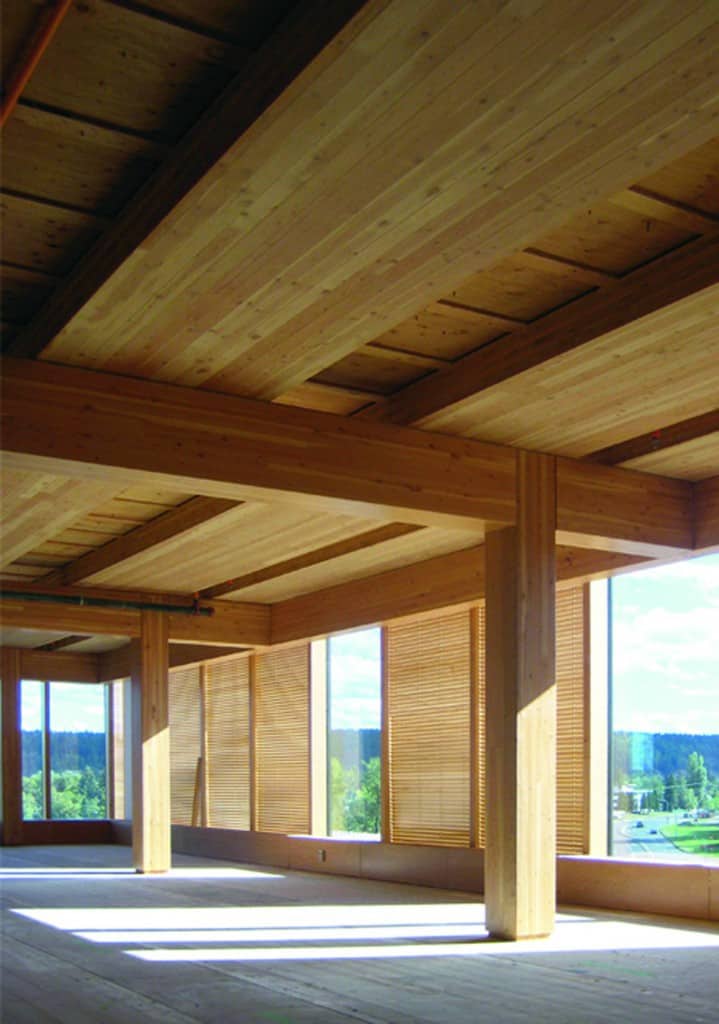Tall timber in taller buildings
Kevin Ezard discusses the increasing use of timber in tall buildings in Australia and around the globe.
Tall timber buildings have become popular in countries such as North America and Canada, with high levels of interest demonstrated by a US$3 million Tall Wood Building Prize Competition recently held to support the design and development of demonstration tall building projects in USA.
At a New York press conference the organisers stated, “By embracing the benefits of wood as a sustainable building material, these demonstration projects have the ability to help change the face of our communities, mitigate climate change and support jobs in building construction.”
Canada has begun to set the pace with architects and engineers racing to see how high they can go, with the current highest underway at University of British Columbia with an all-timber student residence at Brock Commons 53m high and 18 storeys with accommodation for 690 students.
Other all-timber projects include a 13 storey apartment building in Quebec and a 14 storey condo and executive office in Ottawa.
The Building Code in Australia is about to catch up with the world by enabling designers and builders to construct tall timber buildings following changes to the NCC from May next year.
There are at least six projects from 6 to 8 storeys currently in various stages of construction in Australia , and more to come in the next year.

New technologies and building systems have enabled longer spans, taller walls and higher buildings and expand the possibilities for timber construction as a safe and sustainable alternative to concrete, masonry
and steel.
The NCC update for Australia is designed to be conservative and to ensure occupant safety while being commercially viable, based on two key prerequisites – the use of sprinklers for projects above three storeys, and fire resistant plasterboards on all exposed wood.
Forest & Wood Products Australia were behind the submission, and managing director Ric Sinclair stated “One of the advantages of this proposal is its element of deregulation, a deemed-to-satisfy requirement allows a safe harbour – if you meet the criteria, then it’s accepted by the building inspectors.”
Ric added, “The changes could significantly reduce the costs of constructing tall timber buildings, which in turn would make the method more accessible to second and third tier developers.”
The FWPA team is currently in talks with a range of professional associations like the Property Council of Australia, as well as the Commonwealth and State governments to ensure that the building industry is aware of the proposal, allowing them to take on board any concerns.
Timing of the NCC update comes at a time of high activity in the building industry, with the ABS revealing that more units, townhouses and apartments were approved for construction in the first six months of this year than in the entire 2009 calendar year by a factor of 30%.
Following a year of boom in 2014/15, the Australian Construction Industry Forum expects the value of construction work done in the non-detached housing segment of the building market to rise by a further 8.7% to $19.1 billion to $20.7 billion, almost double its level of five years earlier, and to stay at roughly that level until 2018/19.
No doubt these market conditions will increase designer and builder interest in discovering more on timber buildings, and the timber industry’s WoodSolutions are preparing more Technical Guides including “Mid-rise timber buildings” to assist in providing valuable construction details.
The WoodSolutions website offers a one-stop independent source for information and technical details about designing and specifying with timber and wood products, along with case studies, technical guides and span tables to deliver relevant, practical and accurate information to design and building professionals.
To meet growth in demand there are plans to increase supply of local and imported timber products, along with greater production capacity for prefabricated timber and panelised systems, with a number of new manufacturing plants being commissioned over the next year in all eastern states.
All these developments are leading to greater use of ‘builder friendly’ timber in construction and more sustainable buildings for better environmental outcomes.
Along with the rest of the world we are now entering a new chapter in building.
